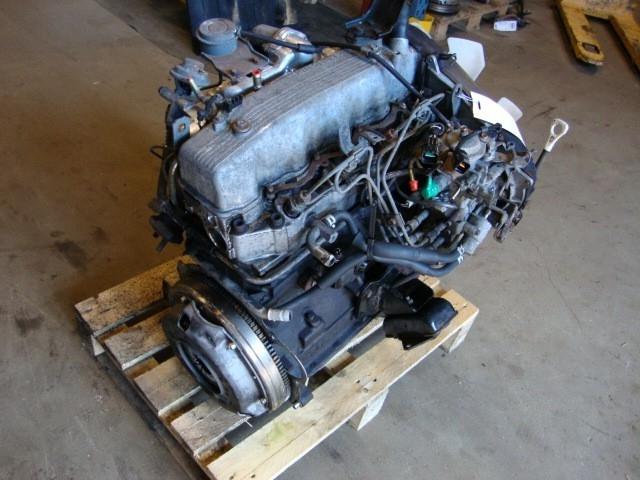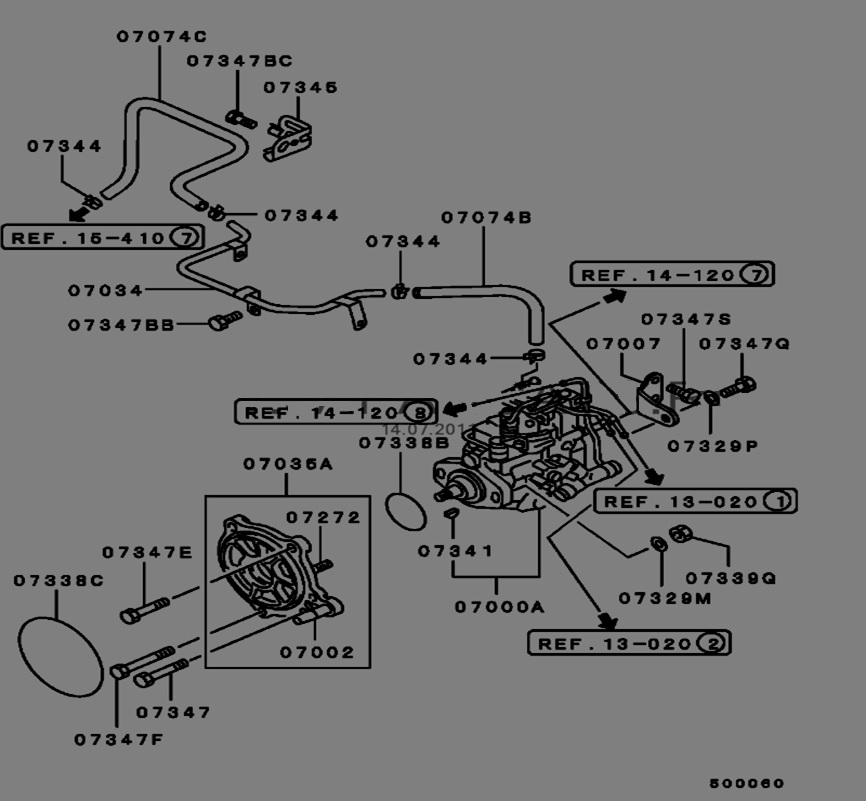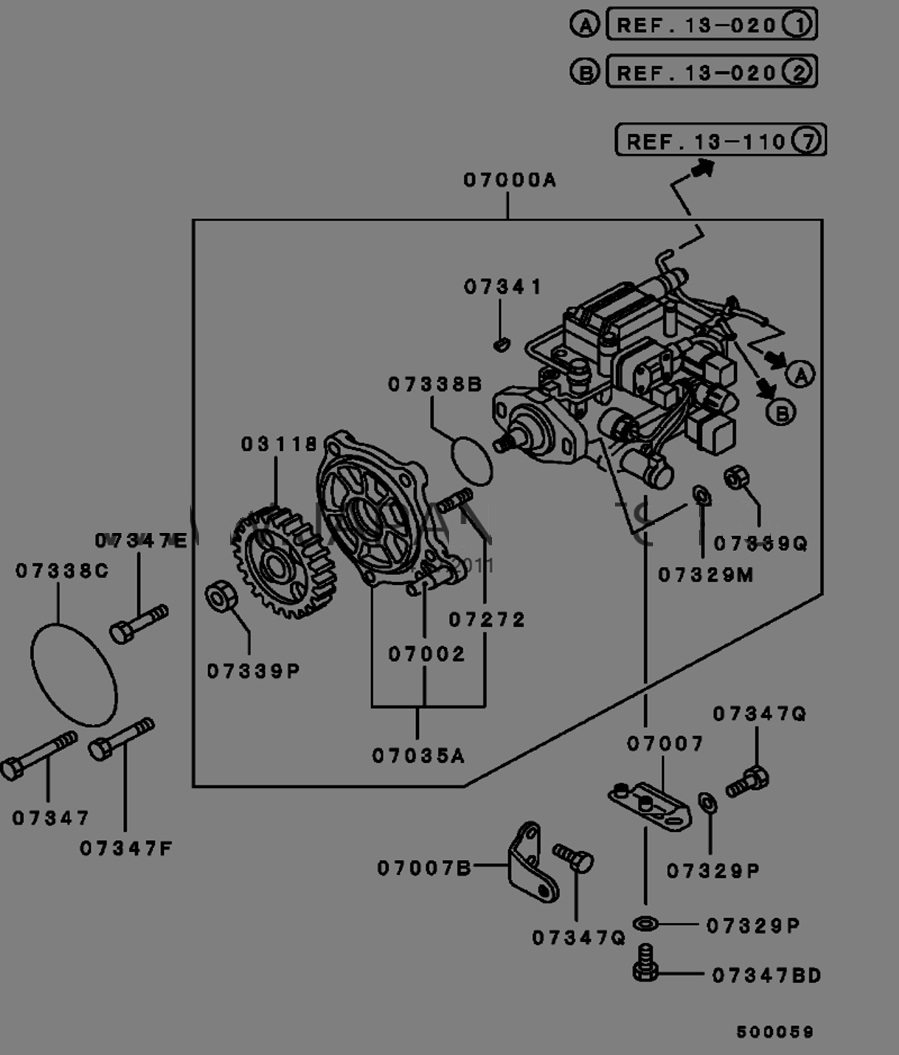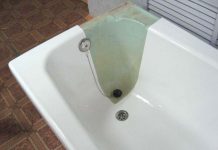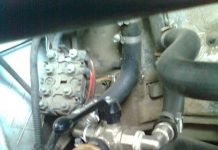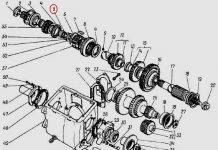The high pressure fuel pump, in short - high pressure fuel pump is an integral part of modern diesel engines. The high-pressure fuel pump is designed to supply fuel to the cylinders in strictly defined quantities in certain cycles of the diesel engine.
ATTENTION! Tired of paying fines from cameras? A simple and reliable, and most importantly 100% legal, way has been found not to receive more “letters of happiness”. Read more"
Also, high pressure fuel pumps may differ among themselves in types, pumps can be of the following designs:
If you do not go into the "jungle" of design differences between pumps of different types, then you can simply identify certain differences between them. In in-line and multi-section pumps, each section supplies diesel to its "own" cylinder. In distribution pumps, one "block" is capable of supplying several cylinders with diesel.
Also, another difference between the injection pump is their "power" - how many cylinders the pump is designed for and its pressure. In general, these are all obvious differences between the pumps. In general, these are the main differences between the pumps.Now we will no longer torment our readers with theories about the operation of injection pumps and their primitive characteristics, which have long been described on the Internet in large quantities. Let's move on to the immediate specifics.
The engine manufacturer Mitsubishi is deliberately omitted here. This is due to the fact that at the moment there are several derivatives of this engine. Accordingly, they have a minimum of design differences, and the injection pump is suitable for both motors.
To be more specific, this is the same engine as the Hyundai D4BH, the pump for it has full compatibility with the 4D56T internal combustion engine (the differences between the 4D56 and 4D56T internal combustion engines are insignificant, the "T" index indicates a turbocharged engine).
The pump itself for the above engines is the only one produced by Zexel (aka Diezel Kiki), and now BOSCH. Yes, final suppliers and packaging may vary, but in the end, injection pumps for these motors can only be obtained from Zexel or BOSCH.
Basically, the accelerated output of the injection pump on these engines is caused by low quality fuel, as well as by the ingress of foreign elements into the system, which often occurs when loose connections and driving over rough terrain, fords, etc.
Until now, the debate about which injection pump for 4D56 / 4M40 / D4BH engines is better, electronic or mechanical, does not subside. How big are the differences in the injection pump themselves and the attachment electronics for the pumps. Is it relevant to replace an electronic fuel pump with a mechanical one.Let's take a closer look.
So, the main difference in this moment is not the pump itself, but the equipment (electronics or mechanics) that activates the fuel supply system, depending on one or another mode of engine operation. In a mechanical injection pump, activation occurs due to the direct mechanical control of the injection pump. A cable runs from the gas pedal to the pump, which controls the system. In an electronic injection pump (EFI), the gas pedal is already electronic and the system is activated through the accompanying electronic units and sensors.
There is also a version about the existence of a cable drive for controlling an electronic injection pump (there is a control rheostat on the pump itself), but our editorial staff could not verify the reliability of this particular information.
Before proceeding with the description of the process of removing the pump from the car, it should be mentioned that this article is not a guide to work on a specific car!
Zexel injection pump (aka Diezel Kiki or BOSCH) is equipped with a large number of cars with 4D56, 4M40, D4BH engines. Moreover, this family of engines is installed on completely different cars in terms of their characteristics and arrangement of units, such as Pajero Sport and Hyundai Oldax, so the attachments will be different in most cases. We will just talk about the pump removal process in general terms, without delving into the design differences between cars of different brands equipped with these engines and pumps.
The pump is removed, now, depending on the problems, it can be sent to the service to the master. Well, or do it yourself if the breakdown is not very serious.
The installation of the injection pump is carried out in the reverse order: installation of bolts, connection of vacuum hoses and electricity, etc. However, it should be noted that when installing the pump, be sure to set the marks in the correct position! In addition, it should be remembered that the elements of the high pressure system must be installed using a torque wrench. We attach the tightening forces of each element during installation:
VIDEO
Once the assembly is completed, it is necessary to turn the crankshaft pulley with a wrench and make sure that there are no extraneous knocks and rattles. Then you should pump the fuel and only then start the car.
Do-it-yourself pump repair is a responsible occupation that requires a large amount of knowledge, experience and the availability of your own equipment, therefore, before deciding on such a crucial step, we strongly recommend that you weigh your chances. Yes, such simple maintenance as installing a repair kit for gaskets and cleaning the filter mesh is not so difficult to perform, and you can do it yourself. But more serious repairs should be trusted by professionals.
The test subject was a mechanical pump removed from a vehicle and washed. One of the simpler repairs is replacing the shaft seal.
To do this, it is necessary to remove the pump drive pulley with a pulley, then remove the old oil seal and install a new one. It is important to note that it is not necessary to press deeply the new oil seal, its adjustment and position should not differ from how the previous one was installed.
Next - cleaning the mesh in front of the plunger pair. To do this, unscrew 4 bolts on the pump body itself, remove the cover, along the way checking the mechanisms for backlash (there should not be any), and carefully remove the plungers and blow out the mesh. Then install everything in the reverse order.
The rest of the repair is more complicated and requires certain skills, even to replace a complete pump repair kit. With a simple repair, it remains to be content with repairing the above consumables and replacing gaskets.
Attention, the editors of the site "Your Road" recommend that you consult with a specialist before applying this instruction to action.
One of the most mysterious parts of a car with a diesel engine is a high-pressure fuel pump (TNVD). There are 2 types of pumps - a mechanical pump and an electronically controlled pump, popularly EFI-shny. Each of the types is divided into 2 subspecies: Multi-plunger in-line, single-plunger distribution type (VE). We will not consider the "exotic" type of pump-injector, Common Rail or VR series distribution pumps (Distribution pump with an axial plunger, Distribution rotary injection pump)
Since the device, and therefore the principle of its operation, is a mystery for many, there is an opinion that specialized equipment and a specially trained person are needed to repair it. However, such a "gentleman's" set is not always at hand, so let's try to disassemble and assemble this tricky knot "on the knee". The object for preparation will be a high-pressure fuel pump, assembled in ancient times from several different-sized pumps, without using stands, but at the same time successfully spinning a 4D56 diesel engine WITHOUT TURBINE up to 8000 rpm. Externally from the high pressure fuel pump installed on your car, it can differ only in the absence of a pressure corrector (a kind of mushroom hat on the top cover) and some attachments. This does not change the essence of the matter.
So, on the table- OH .. Top view
Colored arrows indicate:
Green - fuel supply bolt
Yellow - "return"
Black - pressure valve in the injection pump housing
Red - the axis of the fuel supply regulator ("gas" drive). The "gas" lever itself has been dismantled for convenience.
Brown - mixture "quality" bolt.
Arrows indicate:
Black - automatic heating
Green - drive of the automatic heating device
Red - automatic ignition timing (injection)
Blue - identification plate
Side view (back side):
Blue - speed sensor (tachometer, not always present)
Red - fuel cut-off valve (muffler)
Yellow - pressure valve.
Green is the plunger itself.
Black - the axis of the fuel lever. The same is available on the back of the pump. It is better to remove (but not completely unscrew) them at the initial stage of disassembly.
For work you will need: a set of heads, a set of hexagons, tweezers, screwdrivers, a gas wrench, a caliper, a vice, a clean rag, a container with clean diesel fuel, a grease (Litol, CV joint, etc.) -))
A mesh filter is installed inside, which, as a rule, cannot be washed. Removal has no “contraindications” (yellow arrow).
Has a calibrated hole on the side surface (red arrow). Different pumps have different sizes, so replacing them with another leads to a change in the internal pressure in the pump.
I think no comments are needed. Council - the drive itself should not be disassembled.
Yellow - speed sensor
Green - "jammer".
Black - centrifugal speed controller.
Blue - fuel drive lever.
Here one difficulty is to get to one of the 3 bolts. There are only two options:
Disassemble the drive (carefully, there is a powerful spring! + REMEMBER the setting of the adjusting bolt), and then calmly unscrew the rest.
Unscrew 2 "light" bolts under the key "by 10", loosen the third, "heavy" one, and pushing the assembly aside, slowly unscrew it.
It should look like this:
Yellow - O-ring
Red- adjusting bolt of the automatic advance switch
Green - the cover of the advancing machine.
Remember (write down) the bolt head protrusion (red arrow) above the cover (green arrow). If in the process you decide to unscrew this bolt, during assembly it will be necessary to return the dimensions to their original state.
Blue - the axis of the speed regulator.
Black - mating plane.
Attention! For pumps with RIGHT rotation, the thread on the shaft will be LEFT and vice versa!
If you can find a tool, unscrew the pressure regulator.
Now the fun begins. Parsing includes nodes consisting of several parts. Moreover, the details cannot "live" without each other. That is, they simply cannot be confused with each other.
Red - pressure valve body
Green - spring returnable
Blue - valve needle
Yellow - valve seat
Black - sealing washer.
The plug under the red arrow does not need to be unscrewed; it serves to install the indicator. The fact is that the ignition on diesels is placed not so much on the marks. Rather, initially, the moment of injection is set according to the indicator, and only then the mark that we see is applied. We will omit this procedure for now, the turn will come to it.
So, turn off the cap (blue arrow). This is where the gas wrench comes in handy. The thread of the plug is right-hand.
Blue - plunger body
Red - plunger.
At this stage, it is necessary to measure the amount by which the plunger sinks into the body. We measure the results, write them down, they will come in handy during assembly.
We release the fastening screws (but not completely), and gently shaking, we move the plunger body up. As soon as it is free, we finally unscrew the screws and remove the plunger body. You should get the following picture:
Blue - plunger
Yellow - dosing ring
Red - washer - bearing
Brown - base plate
Black - spring
Green - adjusting washers.
Black - Plunger Shim
Red - cam washer.
Green - fuel delivery lever. I managed to take it off earlier.
Attention!! We do not remove the videos, we do not change them in places.
Remove the stopper (shown with a screwdriver).
We see a pin under the stopper.Shown also with a screwdriver (it is magnetized, the pin can be easily removed by it).
Remove the cam washer drive.
In the interior of the vacated space, push the axis of the advancing automaton:
For convenience, I deleted 1 video, there is nothing criminal here. Pull the roller ring outward for the axis of the advancing automaton. Caution, do not use unnecessary effort! At the slightest misalignment, the ring wedges in the body. Attempts to pull it out "insolently" will end in disrepair - the pump casing will be scrapped.
It should look something like this:
For the 2 "horns" sticking out in the depths of the pump, we take out the pump shaft with the gear of the regulator:
We return to the "remains" of the pump:
We release the bolts (blue arrows) and take out the booster pump cover (red arrow).
We turn over the pump housing.
We remove the oil seal (shown with a screwdriver). Warning - don't try to save it, it won't work anyway.
As a result, a bare body with a bushing pressed into it should remain. Like this:
There is no more complex and critical unit in a diesel engine than the fuel injection system, more precisely, its main part - the high-pressure fuel pump. Many mating parts, high-loaded units, the presence of a precision dosing system, make the repair of the injection pump a difficult task even in service conditions. It is all the more difficult to repair the high pressure fuel pump of a diesel engine with your own hands.
In automotive technology, almost everything is repaired, except, perhaps, individual oil seals and cuffs, the repair of which is impossible without special materials. The complexity of setting, diagnosing and repairing the injection pump requires the employee to have skills in working with precision mechanics.
It is simply impossible to adjust according to the factory parameters, without a special diagnostic stand for the repair of the injection pump. During the diagnostic study of the injection pump, it is necessary to check:
cyclic supply of the high-pressure pump, in the entire range of revolutions of the injection pump shaft, at start-up, and after cutting off the fuel supply;
stability of the developed pressure;
uniformity of the injection pump delivery to the fuel injector.
Even having access to a diagnostic stand, and having studied the issue of repairing a high-pressure fuel pump using numerous videos, it is very difficult to qualitatively check and evaluate its work.
In heavy diesel engines, plunger, in-line injection pumps are used. In maintenance and repair, such devices are more difficult, since they require special equipment for its disassembly, therefore we will not consider such high pressure fuel pumps and their repair.
In a passenger diesel engine, a distribution type injection pump is almost always used. Unlike in-line pumps, in a distribution pump, the force is transmitted to the plunger using a profiled cam washer. The design of the injection pump turned out to be more compact, but it is hardly simpler to expect to carry out its repair on the knee.
The most famous and affordable is the Bosh VP44 injection pump. Often, the need to repair the pump internals arises when:
poor traction and incomplete combustion of fuel even under ideal conditions - in the absence of load and a thoroughly warmed up engine;
a sudden failure and stoppage of a diesel engine under load, which is called “death on takeoff”. Usually the scanner in such cases diagnoses the code P1630 and P1651.
the appearance of a diesel fuel leak in the area of the gland seal of the central shaft of the injection pump.
Therefore, we will restrict ourselves to the issue of repairing the injection pump with our own hands by replacing the seals and eliminating the scoring of the working surfaces of the parts.
Before disassembling the pump drive shaft seal, try to move it radially. If play is felt with your hands, it is possible that the reason for the leakage of fuel is the wear of the working surface of the shaft or requires repair of the bearing.
A large number of split planes and mating surfaces of parts required the use of a large number of seals and glands. As a rule, they are made of quality material and last long enough until they are damaged during repair or maintenance. In this case, standard repair kits are used for DIY repair of Bosch injection pumps.
It is quite easy to replace the seal on the shaft position sensor and on the automatic injection timing during repairs. For a better fit, you can drip a few drops of spindle or engine oil onto new rings and rubber bands.
For preventive repair of a Bosch injection pump with your own hands, you will need to disassemble the pump in approximately the following order:
remove the metering valve from the end of the injection pump. To do this, unscrew the four screws of the pressure plate, carefully release the cable of the injection advance valve. By removing the three screws securing the metering valve, you can carefully remove it from the seat;
by unscrewing the fastener on the top cover, you can remove the control board and gain access to the electronics;
we set the position of the shaft, as shown in the photo, remove the camera and get access to the insides of the injection pump;
after dismantling the bearing using a special puller, we get the opportunity to study the potential culprit for the poor performance of the injection pump - the piston of the injection advance unit. There is often surface wear and edge scuffing on the part. You can try to make repairs by polishing the surface, replacing the whole part is much more expensive.
After the repair, the assembly is carried out in the reverse order with the washing of the parts with diesel fuel.
Often, in addition to scoring, on the surface of the pistons there is another reason why the injection pump does not develop the required pressure. This can be due to debris, films or wax build-up on the filter screen inside the pump. There is a mesh on the side of the inlet pipe. Rinsing the channels is a troublesome and ineffective business, it is easier to remove the mesh and blow it with compressed air.
Torn pieces of debris can jam the plunger piston or even break or break the pump drive shaft. Therefore, cleaning should be done very carefully to avoid contamination of the internal cavities of the pump.
Among the many reasons for the failure of the electronic "liver" of the injection pump, the most common is the breakage or burnout of the contacts of the control board and the failure of power transistors. If the knowledge and skills of working with electronic devices allow to carry out a "continuity" of the transistor performance and repair, it is worth trying to identify the cause and replace the culprit with a serviceable element.
To check the condition of the "culprit", you need to carefully open the black cover, which is tightly seated on the rubber seal with screws. It should be removed carefully so as not to damage the seal itself.
The reason for the failure of not only the transistor, but also the entire board could be air trapped in the cavity due to poor performance of the drainage system or the check valve. Often, they try to eliminate the airing by spinning up with a starter, hoping to pump diesel fuel into the high-pressure fuel pump in this way. At this moment, the transistor is open and loaded as much as possible, which leads to intense heating. In an air environment with poor heat dissipation, it will inevitably burn out. In some German cars there is a protection that prevents an attempt to start the engine in the absence of fuel in the highway. For this, a fuel sensor in the tank is used.
Failure of the transistor can be established by "dialing" a tester or by its appearance. The best option for repairing such a malfunction would be to replace the entire control board. Perhaps it is more expensive than soldering, but it will give guaranteed quality and stable operation of the injection pump after repair. As a last resort, give the board and the transistor for soldering to electronics specialists.
When installing and reassembling after repairs, check the tightness of all fasteners.
If during the audit you did not make rash and unreasonable replacements of parts, the assembled pump should work with approximately the same parameters as before. Bosch EPS-815 stand is used as a standard for testing and adjusting injection pump after overhaul.
The video shows how to raise the plunger pressure in a Bosch VE injection pump:
VIDEO
“Diesel Market "- Spare parts for engines: pistons, rings, liners, gaskets, sprayers, candles, plunger pairs, high pressure fuel pumps
AUTOWELT - spare parts for engines of Japanese and European cars
DENSODIESEL - the central distributor of DENSO for diesel injection systems in Russia
Smoke on a cold one is usually bluish, the main reason for the appearance of smoke due to candles is the correct operation of candles for these engines is about 14 seconds. heating then starting, and after that the candles keep heating for some time until the engine warms up for stable operation. In your case, most likely one of the candles does not work, or it is not fully heated, or not correct (that is, heating not the tip of the candle but its middle is all easy to check)
As we noticed, if driving without a balancing belt suits you, then there is nothing to worry about, usually its absence causes a slight vibration at idle, and a hum when driving from 90 km / h more
A small breather is permissible, after all, the engine is not new, the consumption of diesel fuel for the city is normal, as a rule, oil seal leaks (unless of course it does not affect oil consumption with a roach), but it would be better if there were no leaks!
Cars change, friends and the forum remain. [my.housecope.com/wp-content/uploads/ext/1209]
Message Sergey27 "14 Jul 2009, 14:05
Message Shadow from Omsk "14 Jul 2009, 14:30
Message Sergey27 "15 Jul 2009, 16:09
Thanks for the ambulance)
Message Shadow from Omsk "15 Jul 2009, 17:19
Message Sergey27 "16 Jul 2009, 16:16
Message Shadow from Omsk »16 Jul 2009, 19:12
It seems to me that the mechanic messed up, and very much.
1) Blue smoke - badly burning diesel fuel, partly this is indicated by the impeded rotation of the engine by the sterter, it is possible that an early injection. Alternatively, check how easily the engine rotates when the ignition is off, for example, for a ratchet, try to crawl from below. If it rotates tightly, it means that the main bearings have been pulled, and maybe there are problems with the connecting rods. If it rotates easily, turn on the ignition, rotate the dvigun with the ratchet, if it goes in jerks, at first it is easy, then the effort grows which is difficult to overpower and then again easily, most likely an early injection.
2) A powered dvigun will not be thrown and SHOULD NOT. oil through the breather. For grinding rings 5 hours on XX is quite enough. Measure the compression, measure the compression decay time. How are the valves adjusted? Rubbed down? Is the injection advance angle exposed?
There is only one conclusion, extremely unpleasant. Either during the assembly process, they maliciously screwed up with the installation of parts, or parts with poor quality or fit were installed.
Message kutum "15 Aug 2009, 13:11
Message Slk 79 »03 June 2010, 19:31
Message grandfather »04 June 2010, 18:32
Message dumin »04 June 2010, 22:10
Added after 1 minute 45 seconds:
T the high pressure dump pump is a very critical unit. The injection pump shaft is driven by a timing belt. The injection pump has many tasks and functions. Here are the main ones:
one.High pressure fuel supply to injectors;
2. Change in the amount of injected fuel per unit of time at different crankshaft speed;
3. Cutting off the fuel by the solenoid valve when the engine is stopped;
4. Taking readings of revolutions (for a tachometer, etc.);
5. Correction of the amount of injected fuel when the turbine reaches operating speed (vacuum);
6. Heating control (at low coolant temperature, fuel supply increases);
7. Management of the number of idle speed (XX) in connection with the inclusion of an air conditioner, refrigerator (vacuum).
Also, the minimum speed of XX is adjusted, the maximum engine speed is limited. Adjustment of the nominal fuel supply, ignition timing ...
To replace the rubber O-rings, release the injection pump regulator lever. Unscrew the 4 hex screws (5mm) indicated in the figure on the left (item 1).
2 - Vacuum actuator for increasing the speed of XX in connection with the inclusion of the refrigerator, air conditioner or button for increasing the speed XX.
3 - Heating control (adding speed at low coolant temperature).
4 - Lever of the fuel supply control regulator.
1. Heating control device, disconnected from the injection pump by unscrewing three bolts;
2. O-ring at the point where the control arm enters
3. Internal lever; setting an earlier injection;
4. Setting the speed during warming up;
5. Lever for increasing revolutions, outside;
6. Connecting the temperature sensor to the coolant circuit.
1. Cover of the boost pressure corrector;
2. The oil seal of the regulator lever, it is from this place that the fuel sometimes seeps;
3. The screw for adjusting the nominal fuel supply, after adjustment at the stand - is sealed. If you uncontroll him, you can change the cyclic fuel supply with the adjusting rod, - unscrewing it - we decrease the flow, screwing it in - increase ... Without knowledge and experience, we do not recommend touching it, since there is a high probability of engine stalling, increased smoke, poor speed drop. If, nevertheless, when adjusting on a running engine, you overdo it, and the engine starts to pick up speed, urgently unscrew this screw a couple of turns back.
At this point, indicated by the arrow, the governor shaft engages with the governor levers. The regulator shaft is removed from the lever system precisely through this groove, which allows the top cover to be disconnected from the injection pump housing (shown in the figure below).
Carefully remove the axis of the regulator lever from the pump cover. In the event of fuel leaks, as well as after disassembly, it is imperative to replace the annular rubber seal ring on the regulator axis and the oil seal installed in the high-pressure fuel pump cover in the place where the regulator axis comes out.
Consider the operation of a high pressure fuel pump.
Turning the injection pump with the drive down, remove the unscrewed head of the fuel pump. This is done so that the springs, rollers with washers do not fall out.
After all, every detail has its own worn-in place, this must also be remembered and everything must be laid out correctly during disassembly, so that later it is correctly assembled. In the figure on the left, yellow arrows show rollers with washers (installed on the outside of the roller, with the roller washers facing the rollers). Each roller is in its own seat, it is they who are subject to strong mechanical stress, and have significant performance in the "running bass".
Remove the clip with rollers carefully so that they do not fall out! And you cannot change the location of the rollers in the cage, this also applies to the washers.
From the timing belt, torque is transmitted to the cam washer through an adapter (spring clutch).
The spring-loaded mechanical contact forces the plunger to move progressively along its axis and, at the same time, also rotate. Numerous channels are located in the injection pump head, and the pump plunger has slots and through holes in its lower part. Thus, at a certain position of the plunger, the fuel is distributed at the outlet from the injection pump head.
As you can see from the pictures on the left, in the upper end part of the injection pump head there is a solenoid valve for the fuel cutoff.
This valve can be removed and tested separately by applying voltage from the battery (+ to the contact, - to the valve body). A characteristic click will be heard and the valve will retract into the core. Thus, when voltage is applied to the cut-off valve, the fuel supply channel opens, and when the voltage is removed, the fuel channel is closed by a rubber seal under the action of the closing spring. This locking principle is used in our minibuses to stop the engine. Without supplying voltage to this valve, it is impossible to start the engine, even if everything is in perfect order. This method is used by many anti-theft systems that are part of the alarms, built into the break of this control wire.
In the picture left
1. Solenoid valve body;
2. Positive contact of the solenoid coil (the negative contact is fixed on the valve body);
3. A mesh filter installed at the inlet to the plunger.
As you can see, dirt settles on this small filter, which has passed with the fuel even through the main fuel filter, and somewhere the fluff from the filter itself. This filter system prevents other debris from entering the fuel inlet into the plunger, thereby preventing rapid wear of precision surfaces from small debris.
To get this filter from the recess in the injection pump head, I advise you to use tweezers.
Solenoid valve; Rubber sealing ring; Recoil spring; Core - valve; Rubber seal; Fuel mesh filter in the injection pump head. Unfortunately, on the injection pump installed on the engine, access to this valve and filter is difficult, nevertheless, you will know about its location there! And if the fuel comes with difficulty, especially in winter it is pronounced, you should ask a specialist at the service to clean this filter mesh.
Installed tachometer sensor;
Regulator weight holder assembly;
Fuel cutoff solenoid valve installed in the injection pump head
On the right you can see the induction tachometer sensor. It is made sealed. A solenoid is installed inside (the coil resistance is from 600 to 950 Ohm, if there is an open circuit in the sensor circuit, or the resistance does not strongly correspond to the above, the sensor should be replaced). Let's consider the principle of operation of the speed sensor. The gear wheel on the weight holder rotates and each tooth of this gear, approaching the working surface of the sensor, leads
in the EMF coil. In this way, a series of pulses, dependent on the crankshaft rotation speed, goes for processing to the microcontroller, and from there comes the information familiar to our eyes.
Let us consider in more detail the principle of operation of the idle speed increase system (XX), when the engine is warming up, and when the air conditioner is turned on. The figure on the left shows a picture of the interaction of the levers on the injection pump regulator:
1. Vacuum actuator controlled by discharge when the air conditioner is turned on or the button for increasing the speed of XX;
2. A thermocouple that acts on the levers depending on the temperature of the coolant in the system and sets an earlier injection angle;
4. Intermediate lever with adjusting screw.
When the air conditioner is started, a signal is given to turn on the vacuum switch, the vacuum through the rubber tube reaches the diaphragm of the vacuum actuator 1 (in the figure above), as a result of which the pusher is retracted in the direction indicated by the arrow in the figure, acting on the intermediate lever 4.That, in turn, through the adjusting screw presses on the regulator lever on the injection pump, thereby increasing the speed of XX until the air conditioner is turned off.
Now let's look at how the engine warming up is implemented. Coolant (coolant) flows through thermocouple 2. Depending on the coolant temperature, the thermoelement rod changes its position along the axis within 8-10 mm. Thus, a disconnected thermostat is very easy to check, it is enough to substitute it under a stream of hot water or dip the side of the tubes into boiling water, and its stem will move out about a centimeter.
The figure on the right shows the direction of movement of the stem depending on the state (cold or hot). This is what happens when you start a cold engine. The thermoelement stem is pulled inward as much as possible, allowing the strongly twisted spring coil to act on the intermediate lever 4 (in the figure above). In addition, on the inner side of the injection pump housing, the lever sets an earlier injection advance angle until the engine warms up. As the coolant temperature rises, the thermoelement rod extends, neutralizing the spring action, until the effect on the intermediate lever is completely eliminated and the injection angle is returned to the operating position.
The force of action of the spring on the stem can be adjusted with screw 1 (in the figure on the right), after adjustment, tighten the lock nut. Free play in the lever system is retracted using the adjusting screw on the intermediate lever 4.
Thus, the adjusted system will increase the speed to 1000-1100 when starting a cold engine, and gradually reset it to 850 when the engine is fully warmed up.
For clarity, I will give a snapshot in which the principle of operation of the automatic heating and injection advance will be clear:
Positions 1, 2 and 3 indicate the installation locations of the high-pressure fuel pump fine filter. Lint from low-quality fuel filters often accumulates there. In the hollow bolts at the fuel inlet to the high-pressure pump and the return outlet (items 1 and 2), metal meshes are rolled (or nailed), which should be blown out with compressed air and washed, or disassembled and cleaned.
Video (click to play).
We carefully remove the mesh under the cut-off valve with tweezers, before that the terminal with the wire on top is unscrewed and the valve is unscrewed. Be careful, do not overtighten the valve contact, excessive force can destroy the insulator. Under number 5, the minimum idle speed (XX) bolt is shown, when the engine is warmed up and the effect of the heating machine is removed by means of the bolt (item 4), the regulator lever plate should lie down completely on the bolt for limiting the minimum speed of XX (for automatic transmission - 850 rpm, for manual transmission 700..750 rpm), the IDLE UP key should be in the OFF state.

